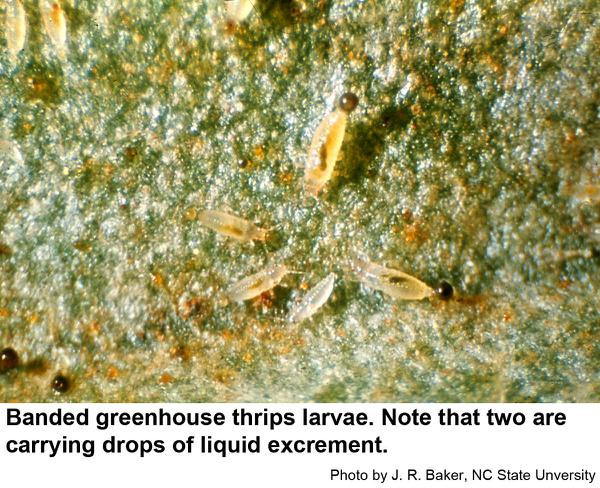Description and Biology
The banded greenhouse thrips, Hercinothrips femoralis, is a pest that occurs outdoors on shrubs, flowers, vegetables and weeds but sometimes manages to get inside to feed on house plants. It is also referred to as the sugar beet thrips because it is thought to have been introduced into the United States on sugar beets. Females are about 1/32 inch long and are primarily yellow at first but gradually darken to brown or black. The eyes are red; the narrow, fringed wings are gray brown with three white bands. Males are rare. When first deposited, the translucent, elongate eggs are white, very tiny, and are deposited on the underside of leaves or along the stem. Before hatching, eggs swell and become dull. About 2 weeks later, tiny larvae hatch and begin feeding. Larvae are white to yellow, wingless, and have red eyes.Colonies of young larvae congregate on the underside of leaves and individuals are often covered with a watery globule of excrement. As the larvae feed, they develop through four stages, molting between each stage. They gradually grow to about 1/32 inch long. Larger larvae are typically found along leaf midribs or among dried-up foliage. In about 18 days, larvae molt into a prepupal stage that is about the same size, white, and has wing pads. Prepupae then molt into pupae that have longer wing pads and antennae folded back over the head. Prepupae and pupae are white and found on leaves mostly on the under surface. Adult thrips that emerge shortly thereafter are less voracious feeders than the larvae. Adults live 40 days or more, and females can reproduce with or without mating.
Host Plants
Banded greenhouse thrips infest many crops including amaryllis, aralia, Arum, banana, begonia, calla lily, cacti, Calonyction, cestrum, chrysanthemum, cotton, Crinum, croton, cucumber, dracaena, date palm, Eucharis, Fatshedra, Ficus grandifolia, gardenia, grape, Hoya carnosa, hydrangea, Lycopersicon, Mexican tea, moon flower, Pandanus, peperomia, philodendron, Phoenix, Plectranthus australis, Quamoclit lobata, rubber tree, schefflera, Scidapsus aureus, screw pine, Syngonium podophyllum, tomato, and Zantedeschia aethiopica. These thrips feed on flowers and foliage. Oviposition and feeding scars reduce the aesthetic quality of ornamental plants. Feeding by a moderate to heavy population causes considerable discoloration of plants. This thrips also bites people causing minor itching.
Residential Recommendations
Unlike some other thrips pests, the banded greenhouse thrips is not reported to be resistant to pesticides. Should this insect become too abundant in spite of various predatory insects and mites, one of the houseplant spray mixtures should give adequate control. Outdoors, any insecticide labeled for residential landscape use should also give satisfactory control. These insecticides are available at most plant shops and garden centers.
References
- Banded greenhouse thrips. Anonymous. No Date. Pest Profiles: Rasping Insects
- Flower Thrips. Frank, S. et al. 2010. Entomology Insect Notes, NC State Extension Publications.
- Insect and Related Pests of Flowers and Foliage Plants. Baker, J. R. ed. 1994 (revised). NC Cooperative Extension Service pub. AG-136.
- The Banded Greenhouse Thrips, Hercinothrips femoralis (O. M. Reuter), Damage to Ornamental Plants. Denmark, H. A. 1976. Proceedings of the Florida State Horticultural Society. 89:330-331.
- Thrips of California. Hoddle M. S., L. A. Mound, and D. Paris. 2012. CBIT Publishing, Queensland.
- Extension Plant Pathology Publications and Factsheets
- Horticultural Science Publications
- North Carolina Agricultural Chemicals Manual
For assistance with a specific problem, contact your local N.C. Cooperative Extension Center.
This Factsheet has not been peer reviewed.
Publication date: March 2, 2018
Reviewed/Revised: Dec. 8, 2022
Recommendations for the use of agricultural chemicals are included in this publication as a convenience to the reader. The use of brand names and any mention or listing of commercial products or services in this publication does not imply endorsement by NC State University or N.C. A&T State University nor discrimination against similar products or services not mentioned. Individuals who use agricultural chemicals are responsible for ensuring that the intended use complies with current regulations and conforms to the product label. Be sure to obtain current information about usage regulations and examine a current product label before applying any chemical. For assistance, contact your local N.C. Cooperative Extension county center.
N.C. Cooperative Extension prohibits discrimination and harassment regardless of age, color, disability, family and marital status, gender identity, national origin, political beliefs, race, religion, sex (including pregnancy), sexual orientation and veteran status.



